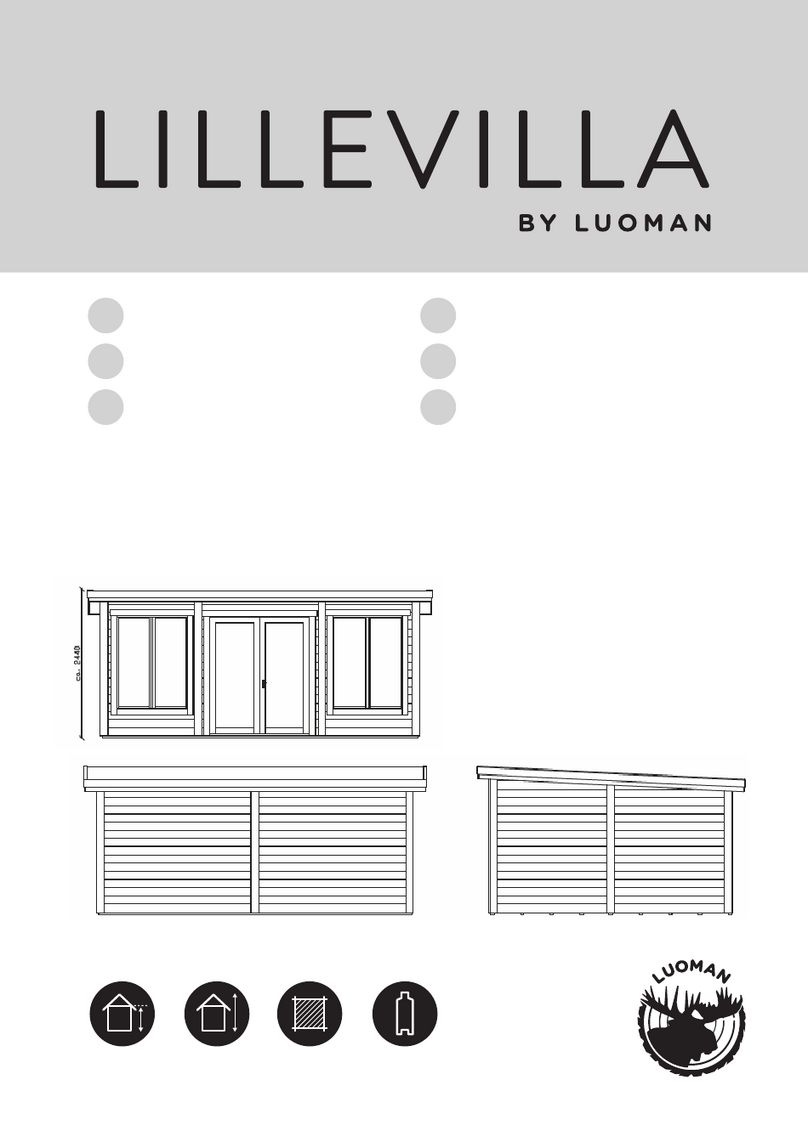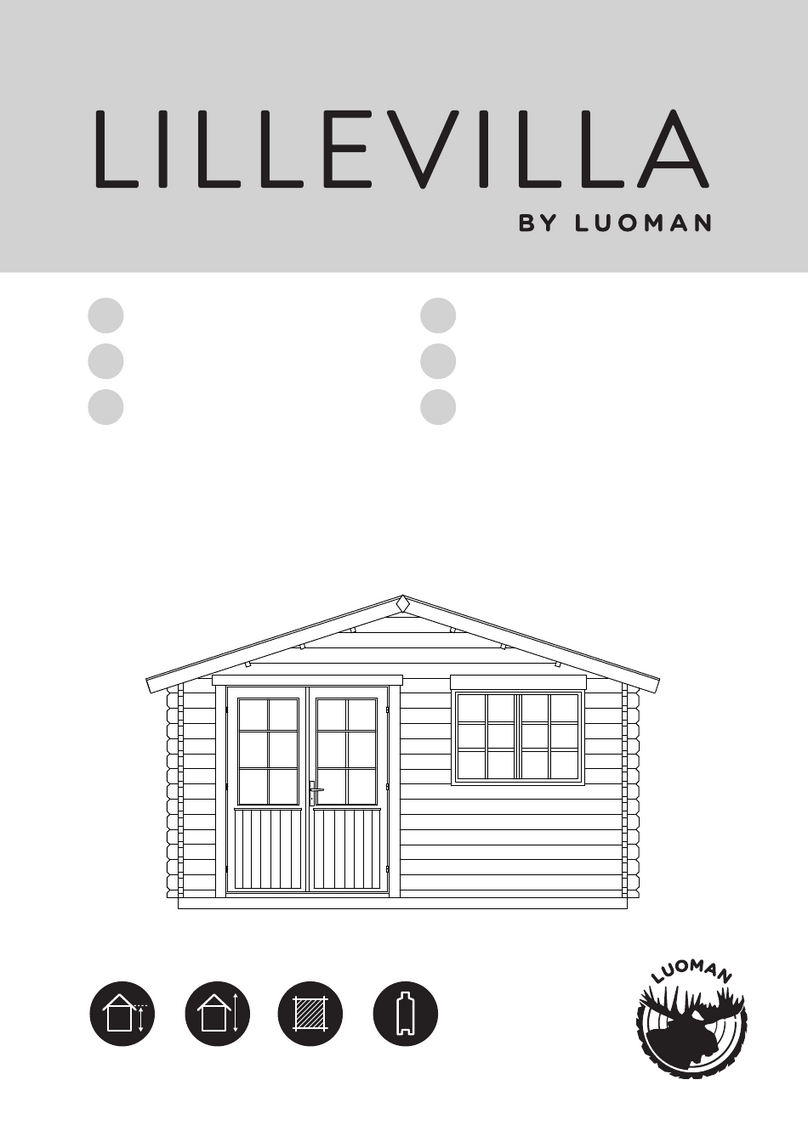Fundament Foundations
Gehwegplatten oder Verbundpflaster auf
(frostfreiem) Kiesbett eignen sich gut, ideal
ist aber (auch für die Belüftung) ein frost-
sicheres Beton – Streifenfundament oder
Punktfundament, auf das die Fundament-
hölzer gelegt und befestigt werden – letzt-
lich ist Ihr ‘Lillevilla 50’ schon ein ‘richtiges’ Haus.
In der Übersichtszeichnung finden Sie die Maße
Ihres Hauses – so können Sie Ihr Fundament vor-
bereiten – die 7 Fundamentkanthölzer fürs
Gebäude (3,80m lang) werden längs angeord-
net, die 7 Stück T14, 1,50m lang folgen parallel
für die Terrasse, die 2 Stück T15, 0,50m lang unter-
stützen die Eckpfosten des Terrassengeländers und
die erste Diele am Eingang – Explosions-
zeichnung + Zeichnung 8 Terrasse.
1.
Lillevilla 50
Das A&O für die Stabilität, Funktion und
Haltbarkeit Ihres Hauses ist ein gutes
Fundament. Nur ein absolut waagerecht
ausnivelliertes und tragfähiges Fundament
(auch für die Terrasse) gewährleistet
einwandfreie Passung der Blockbohlen,
Türen, Fenster sowie gute Stabilität.
Flagstones or paving bricks on top of
a (frost-free) bed of gravel are suitable,
but frost-resisting concrete (either over
the whole area or in the form of piers)
is also ideal as a base for the floor-
joists (and is also good for ventilation).
After all, your "Lillevilla 50" is a "real" house.
In the general drawing you will find the dimensions
of your cabin – to allow you to prepare your foo-
tings – the 7 pedestal beams for the cabin (3.80 m
in length) are laid lengthwise; the 7 T4s, 1.50
m in length, follow parallel for the veranda, the 2
T15s, 0.50 m in length, support the corner posts
of the veranda's balustrade and the first floorboard
at the entrance. See close-up diagram and
diagram 8 showing the veranda.
The key to stability, functionality and
endurance is a good foundation for your
summer house. Only absolutely level,
strong footings (for the veranda as well)
ensure a perfect fit for the timbers,
the doors and the window while
guaranteeing stability.
Fondation
Vorsortierung Pre-sorting 2.
Trier
Des dalles de ciment ou des pavés com-
posites sur du gravier (antigel) sont pos-
sibles; L’idéal serait aussi (pour des raisons
d'aération) un béton résistant au gel – du
béton strié ou piqueté, sur lequel les
poutres de fondation sont posées et fixées
– car votre chalet "Lillevilla 50" est comme une
"vraie" maison. Le plan de disposition d'ensemble
vous donne les dimensions de votre chalet pour
préparer la fondation. Les 7 poutres de fondation
(3,80 m de long) pour le bâtiment sont disposées
dans le sens de la longueur. Les 7 pièces
T14, 1,50 m de long, suivent en parrallèle pour la
terrasse, les 2 pièces T15, 0,50 m de long,
soutiennent les piliers d’angles de la terrasse et la
première planche à l'entrée – Voir le schéma 2
+ schéma 8 Terrasse.
Pour être assuré d'avoir un chalet stable,
fonctionnel et durable, il convient d'avoir
une fondation solide. Seule une fondation
absolument plane, nivellée et solide (pour
la terrasse aussi) garantit que les madriers,
portes et fenêtres seront bien montés et que
la construction sera bien stable.
Hierzu bedienen Sie sich bitte der Explosions-
zeichnung und Zeichnung 1,die Ihnen alle
Teile der 4 Wände zeigt und Ihnen einen
Überblick über den gesamten Aufbau gibt –
die Terrasse vorab gesondert legen.Die ein-
gedruckten Bezeichnungen erlauben eine ein-
fache Prüfung und Zuordnung anhand der
Maße auf den Teilelisten – hier haben wir noch
einmal alle Teile mit Bemaßungen (ca.) auf-
geführt. Beachten Sie, daß die BOHLEN
der VORDER- und RÜCKWAND durch-
gehende BOHRUNGEN für’s Zuganker-
system haben – deswegen nicht mit den
SEITENWANDbohlen vermischen!
Lassen Sie sich bitte nicht durch die auf
den ersten Blick etwas verwirrende Vielzahl
von Teilen beim Öffnen des Bundes schrecken
– vorsortiert ist alles viel einfacher!
Pre-sorting - you don't need to worry about
the number of parts when you open the pack-
age – everything becomes much easier once
you have sorted the pieces into their
appropriate categories!
Prenez les schémas 1 + 2 qui montrent tou-
tes les pièces des 4 murs et donnent une vue
d'ensemble de la construction. Mettez de côté
ce qui concerne la terrasse. Les schémas vous
permettrons de procéder à la comparaison des
pièces et de les classer par dimensions – tou-
tes les pièces sont listées avec leurs dimensions
approximatives.
Attention: les madriers des murs AVANT
ET ARRIÈRE sont munis de TROUS
PERCÉS tout le long pour le dispositif
d'ancrage – ne les mélangez pas avec
les madriers des PAROIS LATERALES!
Ne vous laissez pas impressionner
par le nombre de pièces en ouvrant le
colis – Une fois trié et ordonné, tout
est plus facile!
5
111104
Please refer to the close-up diagram and dia-
gram 1 for assistance. This shows all the parts
belonging to the 4 walls and gives you a guide to
assembling the entire structure. Lay the parts for
the veranda separately to begin with. The refe-
rences on diagram 1 allow you to compare
them with the list of parts and allocate
them according to their dimensions – all the parts
are listed here once more, together with their appro-
ximate measurements. Please ensure that the
planks for the front and rear walls have
drill holes all along for the tension rod
system – for this reason, do not mingle
them with the planks for the side walls!
D GB F
2





























